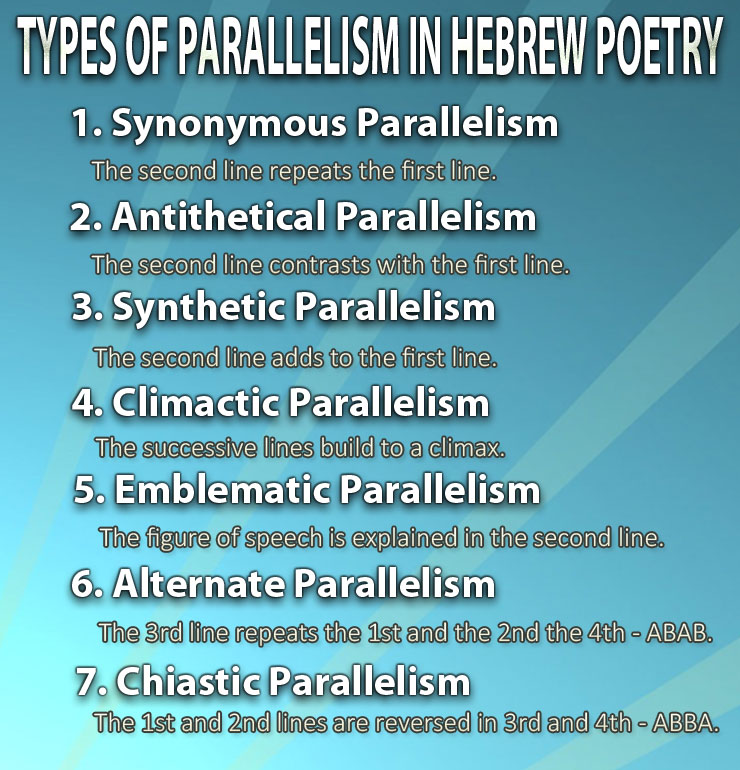Types of Parallelism in Hebrew Poetry: Poetic language in the psalms is set within the structure of biblical poetry. The most common and repeated structure is parallelism. In other words, biblical poetry consists of a distinctive type of sentence structure and it is called parallelism. Biblical poetry is predominately written in this verse form of parallelism.

Types of Parallelism in Hebrew Poetry
Parallelism describes the recurrent use of a relatively short sentence-form that consists of two (couplets) or more (triplets) brief clauses or phrases.
“The LORD of hosts is with us; the God of Jacob is our refuge” (Psalm 46:7).
“Therefore the wicked will not stand in the judgement, nor sinners in the assembly of the righteous” (Psalm 1:5)
“Blessed is the man, who does not walk in the counsel of the wicked, or stand in the way of sinners, or sit in the seat of mockers” (Psalm 1:1).
The two parallel parts are regularly separated by a slight pause (with a comma) as in the two examples above. The second part is a continuation of the first part. It is not a completely new beginning. The second part of the final part ends in a full pause (period).
When you study the psalms, you need to understand how these parts relate to each other. There are several types of parallelism in Hebrew poetry.
In this article I will refer to seven types of parallelism in Hebrew poetry. Some scholars may refer to three or four major types of parallelism in Hebrew poetry and place minor types or less used types as sub categories of the major types. Nevertheless, I generally see seven types of parallelism in Hebrew poetry.
1. Synonymous Parallelism
Synonymous parallelism is the most common type of Hebrew parallelism. The second part of a synonymous parallelism simply repeats or restates the main idea of the first part. To put it another way, the second line repeats or restates the first line in different words by having similar meaning.
“Why do the nations conspire and peoples plot in vain” (Psalm 2:1).
“O LORD, how many are my foes! How many rise up again me!” (Psalm 3:1)
2. Antithetical Parallelism
The antithetical parallelism states a truth in the second part that contrasts the idea in the first part. The contrast impacts the reader by stating the direct opposite.
“For the LORD watches over the way of the righteous, but the way of the wicked will perish” (Psalm 1:6).
“For evil men will be cut off, but those who hope in the LORD will inherit the land” (Psalm 37:9).
3. Synthetic Parallelism
The synthetic parallelism uses the second part to advance and develop the proposition in the first part.
“Who shall ascend the fill of the LORD? And who shall stand in his holy place? He who has clean hands and a pure heart, who does not life up his soul to what is false, and does not swear deceitfully” (Psalm 24:3-4).
4. Climactic Parallelism
In a climatic parallelism the second part completes the first by repeating part of the first line and then adding to it.
“Ascribe to the LORD, O families of the peoples, ascribe to the LORD glory and strength” (Psalm 96:7).
“The floods have lifted up, O LORD, the floods have lifted up their voice” (Psalm 93:3).
5. Emblematic Parallelism
An emblematic parallelism is formed with a symbol or metaphor (first part) that is placed side by side (in parallel – second part) with its meaning. To put it another way, a figure of speech in the first part is explained in the second part.
“As the deer pants for streams of water, so my soul pants for you, O God” (Psalm 42:1).
6. Alternate Parallelism
The alternate parallelism employs the ABAB pattern. The third part repeats the first part and the fourth part repeats the second part. The alternate parts may be either synonymous or antithetic.
“For as high as the heavens are above the earth, so great is his love for those who fear him; as far as the east is from the west, so far has he removed our transgressions from us” (Psalm 103:11-12).
7. Chiastic Parallelism
The chiastic parallelism takes the terms in the first part and reverses them in the second part in order to present AB/BA pattern. To put it another way, the second part advances the first, then restates the second part in the third and finally returns to the idea in the first part.
“We have escaped like a bird, our to the fowler’s snare; the snare has been broken, and we have escaped” (Psalm 124:7).
“Every day I will praise you and extol your name for ever and ever” (Psalm 145:2).
The Function of Parallelism in Hebrew Poetry
Biblical poetry is based on “thought lines” not rhymes. Therefore it is helpful to understand how the thought lines relate to each other. That’s why you need to understand the types of parallelism in Hebrew poetry. However, you must be careful not to get a lot of interpretive mileage out of parallelism. By itself, parallelism rarely affects the meaning of a statement or solves an interpretive problem. So what is the point or function of parallelism in Hebrew poetry?
1. Biblical Parallelism Produces Artistic Beauty and Enjoyment
Parallelism is an example of the skilful handling of language and it gratifies the artistic desire for balance, symmetry, rhythm and shapeliness. The writers of biblical poetry were artists with a love of beauty and eloquence.
“Ascribe to the LORD, O mighty ones, ascribe to the LORD glory and strength. Ascribe to the LORD the glory due his name; worship the LORD in the splendour of his holiness” (Psalm 29:1-2; NIV).

2. Biblical Parallelism Increases the Impact of a Statement
Biblical parallelism draws attention to a thought and focuses on that thought before moving on. It reinforces a thought into our consciousness. The repetition helps the reader to hold on to the thought being expounded.
“Bless is the man who does not walk in the counsel of the wicked, or stand in the way of sinners, or sit in the seat of mockers” (Psalm 1:1).
Concluding Comments
If you wish to learn more about the types of parallelism in Hebrew poetry, then you may want to purchase some of the books below. Most of the thoughts above were garnered from the books highlighted below.
Resources For Parallelism in Hebrew Poetry
Words of Delight: A Literary Introduction to the Bible by Leland Ryken
Holman Old Testament Commentary of the Psalms (Volume 1 & Volume 2) by Steven J. Lawson
An Expositional Commentary of the Psalms (Volume 1, Volume 2 and Volume 3) by James Montgomery Boice
A Commentary of the Psalms (Volume 1, Volume 2 and Volume 3) by Allen P. Ross
The NIV Application Commentary of the Psalms (Volume 1) by Gerald H. Wilson
The Dictionary of Biblical Imagery by Leland Ryken
The Ideal of Biblical Poetry: Parallelism and Its History by James Kugel
The Dynamics of Biblical Parallelism by Adele Berlin
Figures of Speech in the Bible: Explained and Illustrated by E.W. Bullinger